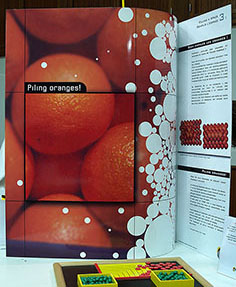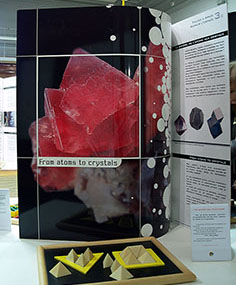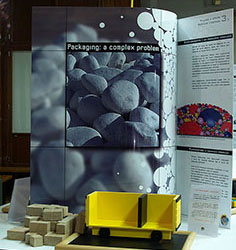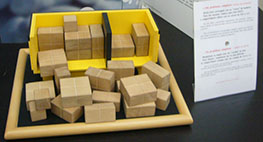3.1- Piling oranges!

How to pile oranges to occupy the least possible volume?
In displays, oranges occupy 74% of the space.
It is the "face-centered cubic packing" which is well known by crystallographers.
Kepler thought, four centuries ago, that this arrangement was the best.
It was only in 1998 that it was proved, by studying, with the help of computers, more than 5000 different cases.
This problem of everyday life has applications which include the study of crystalline structures and the theory of codes.
But if we want to fill a box of given shape, the problem is still without a general solution.
- Johannes Kepler (1571-1630)
Experience on table
The Best Sphere Packing

A- How many unit discs can be placed in a square of
1 unit? 2 units? 3? 4?... 10 units???
B- Place in a box as many balls as possible.
What pile is the most condensed?
Que retenir ?
A- In a square of 10 units, you will place more than 100 disks! In the plane, maximum density for identical disks is 90.6%.
B- In 3rd dimension, when the sphere packing is regular, maximum density can be obtained (like crystal lattices) when marbles are in summits and centres of the faces of a pile of cubes.
This sphere packing is called “faces-centred cubic packing”. Its density is 74%.
For irregular spheres packing, the problem was solved twenty years ago.
Idea & Realisation: Centre•Sciences & Polytech—Paris
3.2- From atoms to crystals

Sky, earth, atoms and elementary particles...
Why is the sphere (entire or in part) often used to represent natural forms ?
At the microscopic scale, natural phenomena can be modelled by undeformable spheres, moving freely or colliding without loss of energy.
If atoms are modelled as spheres, crystals are thought of as orderly, and most frequently periodic, layers of atoms. These phenomena are like elements of an infinite game of billiards in three dimensions: these models permit the study of gases, liquids and certain solids.
Experience on table
How do we Build a Pyramid?

With this two types of littles pyramids, try to build a big pyramid twice as tall as the little.
Compare the volumes of the two types of littles pyramids.
To remember
A pyramid twice as tall is eight times bigger than the little pyramids.
By reorganization, one can compare the volumes of these two types of pyramids.
With three levels of piles, one can even find the formula for any pyramid: Volume = (Base x Height)/3
With other solids, the packing problem is generally much more difficult!
Idea & Realisation: Centre•Sciences
3.3- Packaging: a complex problem

Which occupies the smallest volume : a kilo of coffee beans or a kilo of ground coffee ?
This little problem becomes important if you want to transport tons of coffee!
The problem becomes very complex if the items are of different sizes and shapes and are to be transported in well defined containers. Conversely, how should one find the best dimensions for objects to fill a given volume ?
These problems, conditional also on the weight of the objects, the cost of the transport, the expense of storage, etc. have not yet been solved.
Experience on table
A Complex Problem: How to fill a wagon?

Try to fill at most the wagon with these wooden cases.
To succeed, begin by the cubic part with only 1x1 and 2x2 cases.
To remember
In daily life we encounter the following problem: “How can we put the maximum of objects in a box or the maximum of boxes in a car’ trunk.
For mathematicians, among others, it’s a complex problem: The more objects there is, the more time spending is the solution. And this time increases in an exponentially way. Idea & Realisation: John Conway (GB) & Centre•Sciences
© Photos: Jennifer Plantier, Lyon Museum
